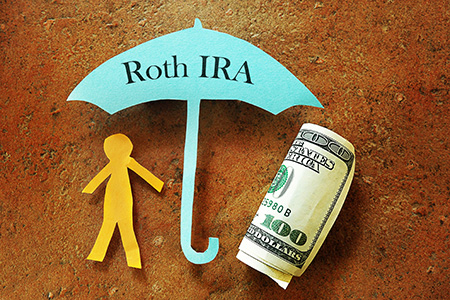Living through this pandemic is certainly putting things in perspective. Our health and our loved ones have never felt more important as we reevaluate what matters most in the face of uncertainty.
Our financial future is no different. The pandemic is nudging many of our clients to revisit their investing plans to put them in the strongest position to thrive over the long term. One strategy worth considering is converting some or all of a traditional IRA into a Roth IRA as the benefits can be pretty significant. Here are a few reasons why now is an ideal time to get it done.

A Roth IRA Conversion Could Reduce Your Future Tax Burden
Contributions you make to a traditional IRA are tax deductible—meaning they lower your taxable income. As such, you’ll pay taxes later on when you eventually withdraw funds during retirement. It’s also worth noting that doing so prior to age 59½ will trigger a 10% penalty.
Roth IRAs, on the other hand, are funded with after-tax dollars. So while you can’t deduct your contributions, you can withdraw them whenever you want with no taxes or penalties. (You just can’t touch the earnings until you’ve had the account for five years or you reach 59½; whichever comes first.)
Converting a traditional IRA into a Roth IRA is one way to potentially reduce how much you ultimately pay to Uncle Sam. Thanks to the Tax Cuts and Jobs Act, which expires after 2025, current tax rates are now lower. If you’re expecting to have a higher tax rate in retirement, leveraging a Roth IRA conversion today could end up reducing your overall tax bill. The same goes for investors who’ve suddenly found themselves in a lower tax bracket because of a coronavirus-related job loss or salary cut.
One drawback of converting funds into a Roth IRA is that the size of the conversion could inadvertently push you into a higher tax bracket. A way to minimize the tax ramifications would be to set up a strategy to execute partial conversions over multiple years.
While we’re on the topic of tax rates, another detail to remember is that the federal deficit is currently on the rise due to the government’s response to the COVID-19 crisis. Congress has passed trillions in fiscal programs, with the Federal Reserve adding trillions more in stimulus money. As such, many are speculating that future tax rates could end up increasing in kind.
Roth IRA Conversions Cost Less When Stock Prices Are Down
Another reason to consider a Roth IRA conversion right now is that the tax bill for doing so is cheaper for investors when stock prices are down, making now a particularly ripe time to consider moving money into a Roth IRA. And remember: when stocks do eventually rebound, that money will grow tax-free. When you’re ready to retire, that money will also be waiting for you without the tax obligation—and if you encounter a financial emergency before then, your contributions could double as a last-resort safety net.
You’ll Sidestep the Required Minimum Distribution (RMD)
With traditional IRAs, you have to start taking Required Minimum Distributions (RMDs) beginning at age 72 (70½ if you reached this age prior to January 1, 2020). It should be noted, however, that the CARES Act has suspended RMDs for this year. This means you won’t have to withdraw funds from any money you end up keeping in a traditional IRA. It’s an important detail because it effectively lowers your tax liability for 2020. As a result, you’ll pay less for a Roth IRA conversion.
Roth IRAs are also beneficial in that RMDs never apply. In other words, you have the option to keep that money invested—and growing—if you want to. The federal government can’t force your hand here. Having that kind of freedom is one of the Roth IRA’s many perks. Consider it a trade-off for not getting the tax deduction you enjoy with a traditional IRA.
What If I Earn Too Much to Open a Roth IRA?
It’s worth mentioning that Roth IRAs do come with modified adjusted gross income limits that can be restrictive for high-net-worth investors—$139,000 for individuals; $209,000 for married couples filing jointly. However, conversions represent a legal loophole. Even if you earn too much to open a Roth IRA the old-fashioned way, you can still do a conversion; a move known as a “backdoor Roth.” You simply deposit your money into a traditional IRA, convert some or all of the funds into a Roth IRA, and then cover the tax liability. Your income never comes into play.
As far as contributions go, the most you can kick in to a traditional and Roth IRA combined in 2020 is $6,000 ($7,000 if you’re 50 or older).
Sorting through the nuances of a Roth IRA conversion can be a lot to digest, but for many, the benefits are worth it. At JJ Burns & Company, we help investors take a closer look at their individual plans to decide if it’s a financial strategy that makes sense for them.
Every investor’s timeline and goals are unique to them, and that’s what drives the personalized guidance we bring to the table. Reach out to our team today if you’re considering a Roth IRA conversion.




